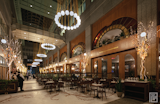Credits
From The Prestige Group
LA GRANDE BOUCHERIE, designed by Julien Legeard (The Prestige Group) and Emil Stefkov (Owner), aims to become a Parisian square in Midtown and one of the most authentically French dining destinations in Manhattan. Located at 145 West 53rd Street, the restaurant stretches the entire block of 6 ½ Avenue of the Americas. This one-of-a-kind brasserie is inspired by the elegant and ornamental Art Nouveau style, which evokes the optimism from the turn of the century, transported to present-day New York. The gallery (outdoor plaza) is stretching from the length of the block, open at each end, and features a soaring, arched skylight and a heated floor. This enables the restaurant to offer year-round outdoor seating options for 150 diners. Inside, La Grande Boucherie has been built to accommodate more than 400 diners in the dining room, bar and mezzanine areas. This makes La Grande Boucherie the biggest outdoor dining area in New York City.









